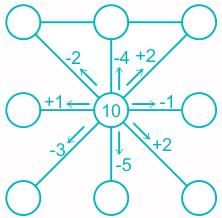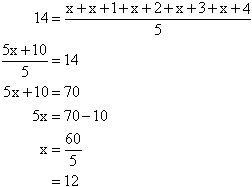CG TET Paper 1 Mock Test - 5 - CG TET MCQ
30 Questions MCQ Test CG TET Mock Test Series 2025 - CG TET Paper 1 Mock Test - 5
The following three aspects of intelligence are dealt with by Sternberg's triarchic theory except:
Directions: Answer the following question by selecting the most appropriate option.
Development proceeds from ______ to ______.
Development proceeds from ______ to ______.
Answer the following question by selecting the most appropriate option.
Learning disabilities may occur due to all of the following, except:
Learning disabilities may occur due to all of the following, except:
According to which theorist 'cultural tools' play an important in the cognitive development of child?
प्राथमिक कक्षाओं में लेखन कौशल का विकास निर्भर करता है-
निर्देशः नीचे दिये गए गद्यांश को पढ़कर पूछे गये प्रश्नों के उत्तर दीजिए।
रामचंद्र शुक्ल के निबंध पं महावीरप्रसाद द्विवेदी द्वारा संपादित सरस्वती में छपने लगे थे। उन्होंने निबंध में प्रस्तुत सूत्रों की उपमा पत्ते की नसों से दी है, जो परस्पर गूँथी होती हैं। शुक्ल जी के अधिकांश प्रसिद्ध निबंध मनोविकारों पर हैं। उन्होंने भारतेंदु, प्रेमघन, फ्रेडरिक पिन्काट पर भी लिखा है, लेकिन वे या तो व्यक्तित्व कृतित्व का परिचय देने वाले हैं, या संस्मरण या जीवनी परक। निबंधकार के रूप में शुक्ल जी का योगदान मनोविकार संबंधी निबंधों के कारण है। इन निबंधों का संग्रह पहले विचार-वीथी के नाम से 1930 ई. में प्रकाशित हुआ था। बाद में चिंतामणि (पहला भाग) नाम से 1939 ई. में परिवर्धित और संशोधित संस्करण प्रकाशित हुआ।
Q. गद्यांश में शुक्ल जी के किस रूप का उल्लेख है?
निर्देश: कविता को पढ़कर निम्नलिखित प्रश्न का सबसे उचित विकल्प चुनिए।
हरा-भरा हो जीवन अपना स्वस्थ रहे संसार,
नदियाँ, पर्वत, हवा , पेड़ से आती है बहार।
बचपन, कोमल तन मन लेकर,
आए अनुपम जीवन लेकर,
जग से तुम और तुमसे है ये प्यारा संसार,
हरा-भरा हो जीवन अपना स्वस्थ रहे संसार,
वृंद - लताएँ, पौधे, डाली
चारों आौर भरे हरियाली
मन में जगे उमंग यही है सृष्टि का उपहार
हरा-भरा हो जीवन अपना स्वस्थ रहे संसार,
मुश्किल से मिलता है जीवन,
हम सब इसे बनाएँ चंदन
पर्यावरण सुरक्षित न हो तो है सब बेकार
हरा-भरा हो जीवन अपना स्वस्थ रहे संसार
Q. 'अनुपम' से अभिप्राय है-
"..... supply comprehensible input in low anxiety situations" is the basis of language acquisition. An example would be:
Directions: Answer the following question by selecting the most appropriate option.
Anaesthesia in any part of the body means a loss of sensation, either permanent or temporary. The term is usually used to describe the artificially produced loss of sensation which makes a surgical operation painless.
There are four main types of anaesthesia: General, Spinal, Regional, and Local. Anaesthetics may be given as gases, by inhalation; or as drugs injected into a vein. A patient given general anaesthesia loses consciousness. Anaesthesia of a fairly large area of the body results from injecting the anaesthetic drug into the spinal canal: all that portion of the body below the level at which the drug is injected is anaesthetised. Regional anaesthesia is the injecting of the nerves as they emerge from the spinal column: the anaesthesia induced by this method affects only that area of the body supplied by those nerves. In local anaesthesia, the drug is injected directly at the site of the operative incision and sometimes also into the nearby surrounding tissues.
Formerly, the most commonly used local anaesthetic was cocaine, a drug extracted from the leaves of the coca bush and introduced in 1879. But cocaine has some disadvantages and, sometimes, undesirable side-effects. For spinal, regional and local anaesthesia, procaine, or one of the several modifications of procaine, is now widely used instead of cocaine, for very limited and short operations, such as opening a small abscess. Local anaesthesia may be induced by spraying (rather than injecting) a chemical, ethyl chloride, on a small area of the skin; in changing from the liquid to the gaseous state, this drug freezes the area sprayed, and permits painless incision.
Q. When a part of the body is anaesthetised,
To achieve communicative competence learners need to be competent in four aspects: linguistic, sociolinguistic, discourse, and strategic competencies. Here, linguistic competence concerns students:
Read the given poem and answer the questions that follow by selecting the most appropriate option.
An example of a metaphor is :
Direction: Read the following passage carefully and answer the given questions.
Once upon a time, there was a greedy merchant who owned a magnificent horse. The horse was strong and fast, and the merchant was proud of it. He would often travel long distances with the horse to trade goods and make a profit.
One day, the merchant had to travel to a faraway city to sell his goods. He decided to take his horse with him as he knew it could cover the distance quickly. However, he didn't consider the fact that the horse would need rest and care along the way.
As they started their journey, the merchant pushed the horse to go faster and faster, not stopping for breaks. The horse was getting tired and was unable to keep up with the merchant's demands. The merchant didn't care and continued to ride the horse harder, thinking only of his profit.
As they travelled further, the horse began to slow down, and its breathing became laboured. The merchant didn't take notice and kept pushing the horse until it eventually collapsed on the ground, exhausted and unable to move.
The merchant was angry and frustrated that his horse had failed him. He cursed the animal and tried to force it to get up, but the horse was too weak to move. Realizing that he wouldn't be able to reach his destination without a horse, the merchant decided to leave the animal behind and continue on foot, leaving the exhausted horse on the side of the road.
Days later, the merchant finally reached his destination, but he had lost a lot of his merchandise along the way. He realized that his greed had led to his downfall, and he regretted his actions towards the horse. He wished he had taken better care of it and had considered its needs.
From that day on, the merchant vowed to treat his animals with kindness and respect and not to let his greed get in the way of his morals. The lesson he learned was that sometimes, taking a break and looking after yourself and those around you is more important than making a profit.
Q. What is the antonym of the highlighted word 'laboured' ?
Read the passage given below and answer the question that follows by selecting the most appropriate option.
In this floating village in Brazil, there is only one way to travel. Students go to school by boat. Locals go to worship by boat. Taxis arrive by boat. Even the soccer field is often a boat. There are three homemade fields on land, but they are submerged now in the annual flooding of the Black River. If the wooden goal posts had nets, they would be useful this time of the year only for catching fish. So, young players and adults improvise. They play soccer at a community centre that has a roof but no walls. They play on the dock of a restaurant. And they play on a parked ferry, a few wearing life jackets to cushion their fall. The high-water mark in the Rio Negro this year was the fifth-highest in more than a century of measurements.
As scientists study the impact of deforestation on the Amazon basin, and the cooling and warming of the Pacific Ocean, extreme patterns observed over the last 25 or 30 years raise an important unanswered question: “Are these trends human-induced climate change, or can we explain this with natural variability?” Villagers said that passing boats sometimes knocked down power lines during periods of exceptionally high water. And while the soccer fields are usually available for about half the year, the land has recently been dry enough for only four or five months of play. “We don’t have a place for the children to play,” said de Sousa, a shop owner. “They are stuck in the houses, bored.” The most adventurous, though, will find a game somewhere.
Q. Flooding has _____ over a period of time.
What is the system of rules that governs how words can be meaningfully arranged to form phrases and sentences?
A teacher can cater to the learning styles of all the children by:
Use of Abacus in Class II does not help the students to
The solid as shown in the figure is made up of cubical blocks each of side 1 cm. The number of blocks is:
After explaining the operation of subtraction in Class Il, teacher drew the following diagram on the board and asked the students to fill in the circles:

The purpose of the exercise is
The mean of five consecutive numbers is 14. Calculate the average of the smallest and the largest numbers.
If the perimeter of a rectangle is 10 cm and the area is 4 cm2, then its length is
The NCF-2005 pronounced that succeeding in mathematics should be seen as the right of every child which can be achieved by:
A child was given the following problem, 'After 3 pens were taken away from me, I had 4 pens left. How many pens did I have to begin with?' A student gave the answer as 1 as according to her, it was 4 - 3 = 1. This reflects that
The best way to assess a child at primary level is to use:
A letter was written with a pen and paper by Reena to her friend Ahmed. It was put in a letter box, it was then taken by a postman. What will happen next?
The idea of showing a sample of a railway ticket in EVS book is to
In EVS curriculum, the Fuels are covered under the major theme Travel. Raju, an EVS teacher initiated the teaching of the concepts of Fuel in an integrated manner. By using this approach, he will be able to make the learner:
Which of the following will be the aim/s of science education at primary level?
|
10 docs|30 tests
|















